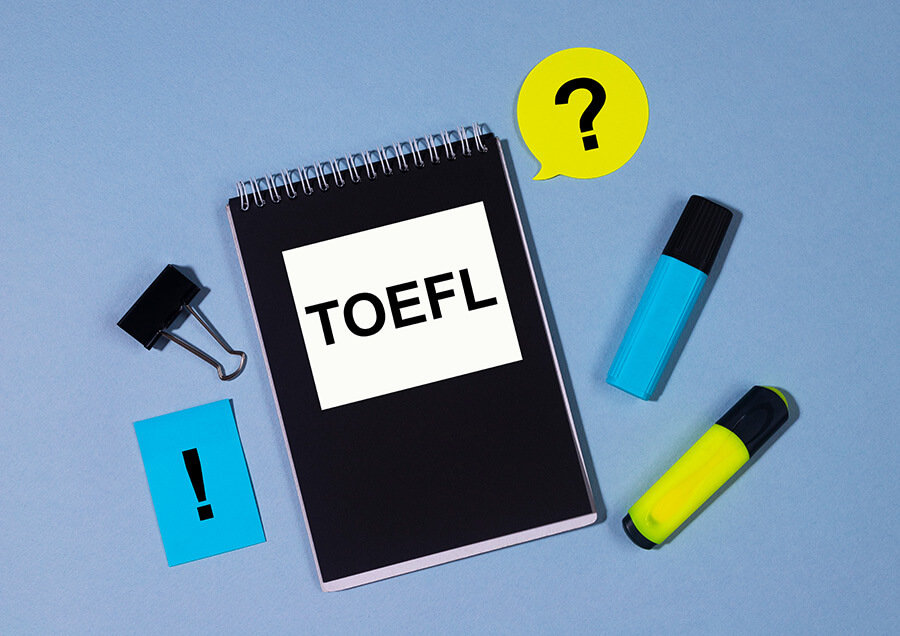If you’re having your eyes on studying in the US, meeting TOEFL requirements will pave the way to your desired college or university. To see if TOEFL is right for you, here is an overview of what to expect of the exam.
TOEFL stands for Test of English as a Foreign Language. This exam allows international students to prove their English proficiency level required to pursue higher education in an English-speaking country.
The test assesses all the usual skills, i.e. speaking, writing, reading, and listening. And since most universities accept a number of English certificates, choosing one can be a matter of personal choice.
Read on to see the main components and questions types of TOEFL.
Follow this link to compare TOEFL to IELTS.
Listening
The listening section of the TOEFL is comprised of four to six academic lecture excerpts and a couple of conversations on topics related to university life.

The section can last anywhere between 60-90 minutes. To anticipate the format of the question, here are the eight TOEFL Listening question types to watch out for.
These questions are multiple-choice questions, so you need to select the most appropriate option in the real exam.
Type One – Detail Question
You will be asked to explain a small insignificant detail that was mentioned in a conversation or a lecture. This information is usually provided as an example in the recording.
Question: Why does the lecturer mention that Great Coral Reef and the habitat it provides to 3,000 species of fish?
Type Two – Inference Question
Here you will need to pay attention to an indirect meaning of some information from the recording. Such questions will ask you to explain what the lecturer is implying when they say XYZ.
Question: What does the professor imply about the experience of cloning large mammals?
Type Three – Attitude Question
These questions require you to explain the intention behind what the speaker is saying.
The tasks are usually phrased as the Why…? questions and you need to elaborate on the speaker’s attitude to the topic.
Question: What is the student’s attitude toward classical music?
Type Four – Function Question
For this question type you will be asked to listen to a part of the lecture again in order to justify what the speaker said.
At first, that piece of information may seem irrelevant because of the slang or an idiom used but you job is to explain why the speaker said what they said.
Question: Why does the professor say this?
Type Five – Gist-Content Question
For this question, you will need to identify the main idea in a specific part of the text. The wording to look out for is “the main gist”, “mainly talks about”, “mainly discussed”.
Question: What are the main points discussed in the lecture? Select three answers.
Type Six – Gist-Purpose Question
For this task, you will need to identify the main purpose of the conversation.
Why is it happening in the first place? What are the expected outcomes of the dialogue?
Don’t go into too much detail for this question but rather look for the overarching theme.
Question: Why did the student go to see their tutor?
Type Seven – Connecting-Content Question
Here you will need to show you understand the relationships amongst some of the ideas from the lecture.
You can be asked to put the answer options into categories or place them in a specific order.
Question: Indicate all the examples of osmosis by checking yes or no.
Type Eight – Organisation Question
For this question you need to pay attention to the way the audio excerpt is structured.
The lecturer could be the only one presenting information or it could be a conversation between several people.
The information can be provided as a sequence of steps to solve a particular solution, or in the form of a Q&A session so that the students are thinking on their feet.
Writing
The TOEFL Writing section has two parts. The first one is TOEFL integrated writing question and the second one is TOEFL independent writing question.

Task One – Integrate Writing Question
For this task you will need to write a 300-word essay based on an article you read and a lecture you listen to on a specific topic.
An argument will be made in the article while the audio recording will present the opposite argument.
In your essay, you should compare the article and the audio and include one paragraph for each opposing pair of arguments.
You will have 20 minutes for this task.
Task Two – Independent Writing Question
The second task requires you to give your personal take on a specific question. You will need to provided arguments that support or oppose the statement in the question.
Topics covered are usually related to lifestyle, work, and education.
You will have 30 minutes for this task and you are to write approximately 400 words.
Speaking
The speaking section is intended to assess your ability to converse in English both in an academic environment and outside of a classroom.
The section has four tasks and will take you 17 minutes to complete.
Question One – Independent Speaking Task
Here you will need to provide your personal take on a specific topic. You will be provided a prompt which will ask you to explain which position better resonates with you.
You will have 15 seconds to prepare and 45 seconds to provide the answer.
Some people think it is very important to have social interactions with neighbors. Others feel it is not important for neighbors to know each other.
Which do you agree with, and why?
A good strategy to approach this question is to come up with one or two strong point that support your position.
Try not to go into the for-and-against mode as you won’t have enough time to provide arguments for both sides.
Use the MEEM acronym to remember structure of the answer:
- Main idea
- Example
- Explanation
- Main idea again
Questions Two to Four – Integrated Speaking Tasks
The rest of the section contains tasks which will assess both your speaking and listening/reading skills.
Integrated tasks will require you to read through a short text or listen to an audio recording on a specific topic. Then the task will be to explain a concept from the prompt.
Preparation time for these questions will be 30 seconds. You will have 60 seconds to record your answer.
To practice the question formats, here is a neat resource with free sample tests.
Reading
Here you will need to read three to four 700-word-long passages on academic topics and answer 10 questions per passage. The section will take 54-72 minutes to complete.
There are several question types that are assesses in this section. Since some of them (inference and purpose questions) overlap with the listening question types, let’s focus on a few that are specific to the reading section.
Reference Question
You will need to explain what a certain pronoun (those, that, etc.) refers to.
Detail Question
Here you will need to select the answer that best explains the what, who, when, where, why question.
Negative Factual Information Question
Here you will need to pick the odd one out. You will be given multiple choice options and asked to pick the one that contradicts the information in the passage.
Watch out for the words NOT and EXCEPT in the question.
All in all, TOEFL emphasises the integrated component of the English language. With its integrated tasks in speaking and writing, consider practicing the multi-tasking skills of both listening, reading, and analyzing under pressure.
Photos: Shutterstock
Want some more advice on learning English? Check out this article:
Support us!
All your donations will be used to pay the magazine’s journalists and to support the ongoing costs of maintaining the site.
Share this post
Interested in co-operating with us?
We are open to co-operation from writers and businesses alike. You can reach us on our email at [email protected]/[email protected] and we will get back to you as quick as we can.










